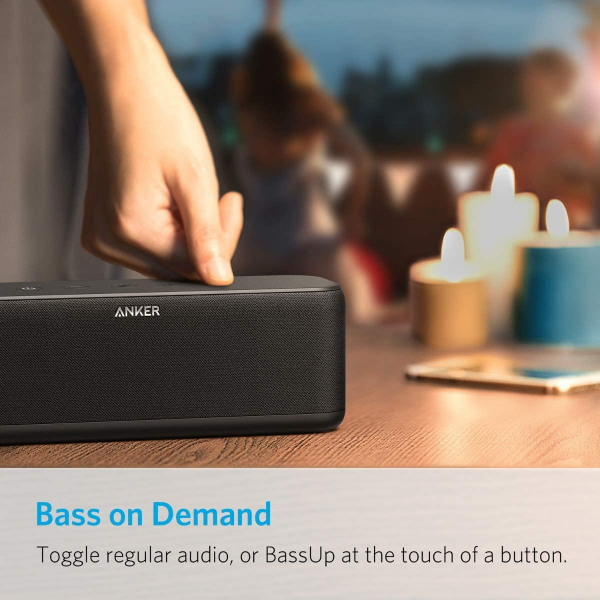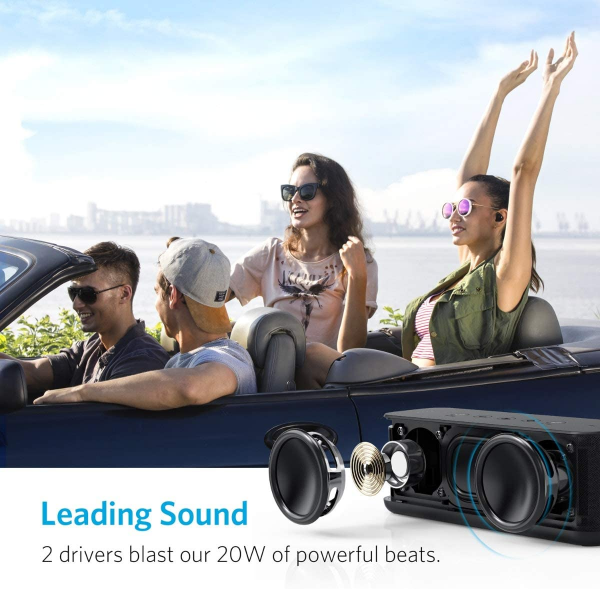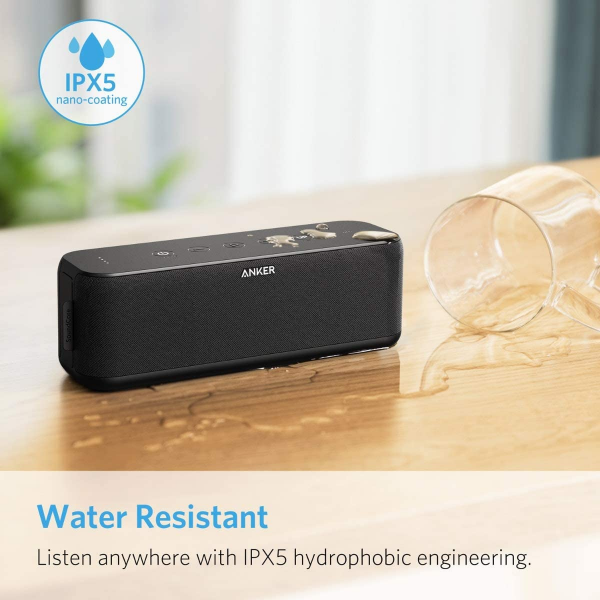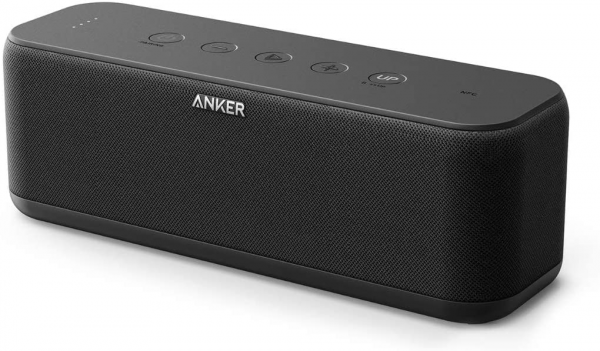Anker
Anker SoundCore Boost: more power, less distortion
Aprox. 59€ - see price -
See specificationsThe Anker SoundCore Boost portable speaker is positioned in a way like a SoundCore 2 having undergone a small course of anabolics: a little bulkier, a little heavier, a little more powerful, a little more expensive ... and significantly more interesting, as we will see.
Positive points
Clean and balanced sound.
Quite energetic restitution, even at low volume.
Hairline hairline.
Good stereophony, weak directivity, excellent sound diffusion.
Robust construction.
Bad points
Small traces of sibilance on aggressive mixes.
No command to return to the previous track.
Our review
Ergonomics
No revolution to report on the design side of the SoundCore Boost, which only takes up the very basic visual language to which Anker has accustomed us. Completely black, the outer casing of the Boost is made of the same rubbery plastic that covers the SoundCore 2. Robust and pleasant to the touch, this plastic also has the quality of not too catching fingerprints - for a material of this type, get along .
The Boost differs from its little sister, however, in its grid, which is made not of metal but of fabric. Said fabric also almost goes around the entire enclosure and also covers the back, for a rather fluffy aesthetic effect. The aluminum logo on the front of the speaker also contributes to an overall appearance that is significantly more elegant than that of the SoundCore 2.
Although the SoundCore Boost is water resistant, this fabric does not benefit from a hydrophobic treatment and therefore tends to mop up the water which is sprayed on it. This is undoubtedly partly what justifies that the enclosure is presented as protected "only" against splashes, and not against immersion (IPX5 certification). Despite this, the fabric does not seem to have anything to blame in terms of solidity.
The top of the speaker houses the control buttons: on / off, volume adjustment, play / pause and activation of the "BassUp" mode - we will come back to the meaning of the latter in the "audio" part of this test. The Bluetooth pairing is launched by a long press on the ignition button, the passage to the next track is done by double pressing the play button. Strangely, however, it is not at all possible to request a return to the previous track. This is the only feature missing from the Boost so that we can talk about exhaustive commands.
Compatible with Bluetooth 4.2, the Boost has an NFC chip to facilitate its pairing and connection to compatible devices. Unfortunately, it is not possible to connect it to several sources simultaneously (a computer and a telephone, for example). The speaker, fitted with a microphone, can be used as a hands-free kit. However, the voice capture provided by this microphone is suitable, but not very powerful: to make yourself understood by your interlocutor, you must not move more than thirty centimeters from the speaker. Calling voice assistants from smartphones is possible, by long pressing the play button.
A waterproof hatch on the left of the speaker conceals the connections: an auxiliary input on 3.5 mm mini-jack, a mini-USB port for recharging the speaker, and a USB Type-A port which allows use the speaker as an external backup battery to charge a mobile device. In terms of autonomy, the SoundCore Boost was able to stay awake for a little over 11 hours during our test at 75% of its maximum volume; it is a little bit less than the 12 hours promised by the manufacturer. The value remains honest, even if we often see better on the market today.

Audio
Although the main marketing promise of the SoundCore Boost compared to the SoundCore 2 is that of higher power, it is in fact another quality that we prefer to note: its sound reproduction is simply much better mastered than that of his little sister.
The family resemblance between the two enclosures is however clearly recognizable. The line can be seen especially in the treble, with this peak at 10 kHz which contributes to the sensation of a fairly brilliant sound, adorned with a little excess of clarity, a little artificial, but not unpleasant. The restitution remains in any case well balanced, as it was on the SoundCore 2 - with the exception of the slight lack of uniqueness of the bass, the resonance at 75 Hz and the hollow that follows being a little too noticeable.
But it is especially when talking about harmonic distortion that the two speakers stand out.
While we regretted the very strong propensity of the SoundCore 2 to distort the signal it was responsible for reproducing, the Boost, it knows how to confine itself to very reasonable values. It is certainly not always perfect - we note in particular around 4 kHz a small bump which, combined with the peak of the frequency response at the upper octave, can induce a slight sibilance on the most aggressive mixes. But the thing remains measured, and the SoundCore Boost can indeed boast overall a clean and very well defined reproduction. The hairline of the sound image is particularly appreciable, the different timbres and layers of each mix managing to detach from each other in a rather surprising way for a portable speaker. It is all the more true that, on this ground, one benefits from the surprising stereophonic width which the enclosure offers in spite of its reduced dimensions. Its not very directional speakers ensure a very good diffusion of the sound and bring a rather beautiful feeling of sound amplitude. Only the dynamics are not entirely ideal, and some transients can sometimes lack punch - snare hits often suffer from this small weakness. Nothing unacceptable, however; the sound remains generally lively and rich.
But let's retrace our steps to evoke again the frequency behavior of the enclosure. Surprisingly, the Boost seems to be equipped with a kind of physiological equalization: the above measurement was carried out with a volume normalized to 80 dB SPL at 1 kHz and 80 cm away, or see what is happening when we lower this volume to 73 dB SPL ...
The frequency response then loses a bit of its flatness, thanks to a strengthening of the bass as well as the treble. A particularly marked character when you activate the "BassUp" function, which then gives a significant boost at the bottom of the spectrum - which it really could not do at high volume. It is difficult to know whether this variation in the behavior of the speaker is a perfectly voluntary effect or a simple lucky consequence of its acoustic design. Anyway, the result is quite pleasant, and the V signature that the speaker acquires at low volume allows it to maintain an energetic and full reproduction.
The maximum sound emission power of the enclosure is 85 dB SPL at peak at 1 m: a rather generous value in relation to the dimensions of the machine; the manufacturer's promise of power is well kept.
Finally, the latency in Bluetooth is around 210 ms. This is higher than the average of portable speakers, and too much to be able to comfortably watch a video without compensation for this offset.

Conclusion
Without being gifted, Anker's SoundCore Boost makes a copy of a good student, studious and serious. No flaws of importance, a simple but neat and robust design, audio performance not brilliant but very pleasant, for a rather soft launch price of € 89: the whole makes it a champion of the quality / price ratio.

Specifications
Reviews


Easily the best wireless speaker under $80.
Anker makes fantastic third-party accessories. What I love about Anker is its commitment to great pricing on products that work and work for a long time.
The SoundCore Boost is no exception. Build is superior to any Bluetooth speaker Anker has built in the past, and the sound is fantastic for the price. The sound is rich and clear, but can also be boosted by the extra bass that comes through the dual woofers. The SoundCore has a great Bluetooth connection - it hasn't dropped out on me even when I bring my phone to other rooms.
Build quality is what you'd get from a major manufacturer like Sony, and the sound is arguably better than the UE Boom 2, and is certainly better than the Fugoo Go. Where the Fugoo Go and UE Boom 2 have an advantage over the Anker Boost is the ability to connect to more than one speaker. In the case of the Boom 2 it can connect to over 50 speakers (not that you would ever own that many) and the Go can connect to a second Go for dual or stereo sound. If you have the latest Samsung Galaxy S8, or S8 + you can connect to two devices simultaneously through Bluetooth 5.0, although you won't be able to get a solid connection on both devices unless you're phone is less than three feet away from both speakers.
I also love that the SoundCore comes with a 5200mAh battery that can be used to play the speaker for 12 hours or charge most cell phones twice.
If you're a demanding listener this speaker will satisfy you and you'll be glad you didn't spend twice as much on big brand names.
So much potential!!! But failed so miserably!!!
Great build quality !!! You get the feeling that the people from Anker really know what they're doing !!! But then, I turned on the unit and started playing music through my app (PowerAmp on an LG V20) and it was all downhill from there. Above 50% volume, the distortion is TERRIBLE !!! Turned down all the low frequencies. The unit was still trying to pump out bass because I could still HEAR and FEEL the woofers [trying to compensate?] Is it trying adjust my music for me? I played with the and equalizer and phone settings all off and the final verdict is: I'M SENDING IT BACK !!!
I have owned an Anker A7908 cube speaker for many years and even though the sound wasn't powerful, it was a great little speaker with great mids and clarity and I love it still. Decided to upgrade to get some better bass. Going to have to go with another speaker. This one is not cooperating.
The sad thing is that the speakers have so much potential !!! They could be so amazing !!! But something inside the speaker is trying to compensate for the low frequencies even after I turn them all down. I wanted to love this speaker, I really did, but it's going back !!!
Update 11/22/2018
I gave it to a buddy and it works for him. He likes it. It doesn't distort for him. Must be something with my phone. Sound is powerful and hopefully it lasts a long time for him because it's an Anker product.
I replaced it with an Anker SoundCore XL Sport - that one sucks. That one is definitely going back. Next stop, JBL Charge 4.
12/4/2018 Ended up buying a JBL Charge 4. No quirks with that one. It worked as it should right out of the box. Sound is awesome!